- December 22, 2017
- Posted by: admin
- Category: Asian Missions Advance #Back Issues
INTRODUCTION
This paper will begin with defining key terms, followed by explanation of the “what,” “why” and “how” of inter-disciplinary and integrative missiological research. Hopefully Christian scholars of multiple disciplines will collaborate in conducting research and Christian leaders will become better stewards of resources and opportunities by making informed decision based on validly collected data through research.
To avoid complication, only five branches of missiological studies (i.e. theory, theology, history, anthropology and strategy of Christian mission) are being included in Figure 1.
KEY TERMS IN MISSIOLOGICAL RESEARCH
- “Missiological research” — “systematic and academic study (e.g. theory, theology, history, anthropology(intercultural studies), strategy of Christian mission) to continue on and carry out the missio Dei of the Triune Go, including investigation and interdisciplinary research.[1]
- “Mission” — “is the endeavor of both individual Christians and organized congregations to continue on and carry out the missio Dei of the Triune God at both micro and macro levels, spiritually (saving souls) and socially (ushering in shalom),[2] for redemption, reconciliation and transformation.”
- “Inter-disciplinary research” — “academic and systematic study conducted by using elements (e.g. theory, methodology, etc.) from one or more disciplines in the attempt to achieve a high degree of coherence or unity.”[3]
- “Integrative research” — “research that is by design to be theoretically coherent, thematically consistent, methodologically complimentary and structurally unified.”
- “Research Methodology” — “ways and approaches employed in academic and systematic study.”[4]
DISCIPLINARY MYOPIA AND ITS CONSEQUENCE [5]
There are seven socio-cultural phenomena of negative nature due to the outcome educational goal of producing “specialist” and the resultant “disciplinary myopia”:
- absence of the cultivation of the whole person with holistic perspective and healthy temperament (e.g. curricular problems of the public school system);
- being succumbed to technological domination (e.g. biological engineering over ethics; population control over human values);
- cultural irrelevance of scholarship: (e.g. training of expert instead of cultivation of personhood and holistic learning);
- disciplinary rivalry (e.g. sciences vs. humanities);
- ethical confusion: scientific accomplishment in science and technology (such as organ transplant, cloning, etc.) surpasses ethical formulation;
- fragmentation of knowledge (e.g. modern specialist vs. traditional scholars, technocrat vs. administrator) with a distorted view of reality (i.e. compartmentalized mindset, tunnel vision, etc.);
- giving into the dehumanizing and depersonalizing forces of contemporary society (e.g. the critique of the Marxist, feminist, liberation theologians, etc.).
CHALLENGES IN THE 21ST CENTURY ARE TO BE MET BY INTERDISCIPLINARY INTEGRATION IN MISSIOLOGICAL RESEARCH [6]
There are seven kinds of challenges Christians face in the 21st century that would call for evangelical cooperative inter-disciplinary research. The first five are external factors and the last two are internal factors:
- postmodernist orientation & the tyranny of the “tolerance principle;”
- pluralistic landscape & anti-Christian / anti-establishment sentiment;
- popularity of “hard sciences” at the expense of the traditional studies, e.g. humanities, theological studies, etc.)
- promising bio-medical engineering, run-away technological advancement, and rapid socio-cultural changes;
- powerful and pervasive forces such as New Age Movement, gay & lesbian movement, environmental activist groups, Easternization (e.g. the increasing popularity of homeopathic medicine and acupuncture), etc.;
- polarization of evangelical scholars: the great divide of liberal vs. conservative (e.g. the “wider mercy of God”) / charismatic vs. “frozen chosen,” the inerrancy debate, the “millenarian fever,” “the third wave,” (including debates on “spiritual warfare” mentality, the merits of “territorial spirits” approach),etc.;
- power struggle among the intellectual elites of evangelical scholarship that are polarized by disciplinary differences, denominational division, etc. that would prevent genuine cooperation and collaboration of the best scholarship from various disciplines.
Organizations such as ETS and EMS are the ideal venues for inter-disciplinary cooperative efforts of evangelical scholars/researchers to demonstrate the spirit of unity and to make significant contributions in the “kairos” moment of human history.
THE IMPORTANCE AND SIGNIFICANCE OF MISSIOLOGICAL RESEARCH
To not make things too complicated, we shall explain the importance and significance of missiological research by selectively choosing only five branches of missiological study as shown in Table 1.
Table 1 Importance and Significance of Missiological Research[7], [8], [9], [10]
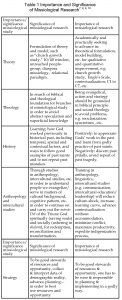
INTER-DISCIPLINARY RESEARCH IN MISSIOLOGY
Inter-disciplinary research in missiology combines and integrates biblical study, theology, anthropology, demographic, statistic, etc., in order to achieve a high degree of coherence or unity in research and for the practice of Christian mission. As evangelical, we are not to be sold out to the newest theory and pragmatic efficiency.[11] Nor should we engage in unreserved contextualization,[12] such as multiple forms of liberation theology (e.g. feminist theology of the west, “minjung theology of Korea,” C.S. Song’s “third eye theology”)
The diagrams below emerged from personal research, professional publication and two-decade-long coaching doctoral dissertation. If inter-disciplinary research in missiological studies is conducted by following the five-step according to priority, then it will be characteristically evangelical, doctrinally sound and theologically grounded.
Table 2 Wan’s Way of Integrative Research (“STARS”)[13]
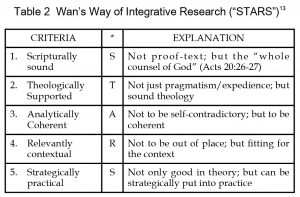
Listed below are simple explanations of each of the five points in Table 2.
- Scripturally sound: As evangelical, Scripture is to be the basis and guide of Christian faith and practice. It is axiomatic for evangelical Protestant based on the conviction of “sola scriptura.”
- Theologically Supported: Just based on pragmatism/expedience is insufficient; but sound theology is essential and required.
- Analytically Coherent: Not to be self-contradictory; but to be both consistent and coherent
- Relevantly contextual: Not to be out of place; but it is to be required to be fitting for the context.
- Strategically practical: It is good to have scriptural/theological support with coherent theory and cultural relevance; but can be strategically put into practice.
Table 3 Comparisons Between “Biblical” and Scriptural”[14]
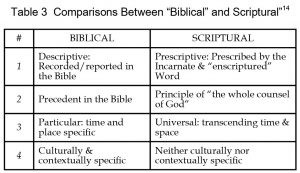
The Bible is full of “description” (#1 in the figure above) of behavior and practice of major figures in biblical times; but not “prescription” for us nowadays. For example, the Bible recorded/reported patriarch Abraham and King David as polygamist; but is prescriptive for us to be monogamist by the teaching of Jesus (Mt 19; Mk 10; Lk 16) and consistent teaching (Gen 1:14; Deut 24:13; Mal 2:15).
Let us use another example to illustrate this point. The selection of a substitute for Judas after his suicide was by “casting lots” (Acts 1) so this way of selecting a leader is merely “biblical” (#2 in the Table 2). Should the Christian church follow that manner in identification and selection of leaders nowadays? In other words, casting lot as a form of decision-making as recorded/reported in Acts 1 is “biblically accurate” but not “scripturally binding” for us to follow today.
There is a popular Christian hymn based on Ps 51:10-11, the psalm of confession written by King David after his adultery relationship with Bathsheba. However, though the hymn is “biblical” (based on Ps 51:10-11), it is theologically incorrect and inapplicable to us. The reason is that David’s confession is “particular” and being “time and place specific” (#3 of the figure above); but is not “universally” applicable to us because Jesus had promised that the Holy Spirit will “be with you forever” (Jn 14:16). King David’s confession and the hymn based on Ps 51 though being “biblical” but is not “scriptural.” The ceremonial law and sacrificial system of the OT is “biblical” as revealed by God in the OT and taught in the Pentateuch. The writer of Hebrews expounded the “scriptural meaning” of the old covenant and related Jewish traditions (#4 the Table above) for us – the NT Christians. The “scriptural teaching” of Hebrew is binding for all people at all times.
Figure 1 Directional Understanding of Being “Biblical” and “Scriptural”
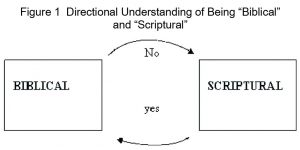
Note: Not all men are husbands; but within thecontext of “traditional Christian marriage,” all husbands are men.
Likewise, whatever is “biblical” is not necessarily “scriptural;” but whatever is “scriptural” should also be “biblical.” Not only “biblical” and “scriptural” are different in meaning and usage, the proper order and the correct direction are also important. For example, when Jesus was tempted, Satan quoted verses from the OT so He is no doubt being “biblical.” However, his use of the Scripture is not “scriptural” at all. Jesus responded to Satan also by quoting verses from the OT (being “biblical”); but his usage is very different from that of Satan because He is both “biblical” and “scriptural” at the same time.
To illustrate the significance and importance of the sequential order of the five elements in “Wan’s Way of Integrative Research,” the mistake of reversing the order will be explained first, followed by the example of the proper sequential order. The use of terrorist means by “Jihad Muslims” to propagate their faith may be practically effective and expediently feasible (point #5 in Table 2). However, the “terrorist way” cannot be used as evangelical Christians in their statements of mission, vision, core values, and strategic goals. It cannot be an option for evangelical Christians for several reasons:
- The message of their gospel is “God so love the world” according to the Scripture – point #1 in Table 2;
- The God they proclaim is the “God of love” theologically – point #2;
- The Christian faith and practice is to be consistently and coherently characterized by “love” – the Great Commandment of “love God” and “love thy neighbor” – point #3 in Table 2.
The “Gospel of wealth and health” and “the positive thinking” approach are popular these days because of “cultural relevance” of our time (point #4 in Table 2) and expedient/practical (point #5 in Table 2) with desirable outcomes quantitatively. However, evangelical Christians cannot ignore the importance of points 1, 2 and 3 in Table 2 and should not “conform to this world” (Ro 12: 1-2). No statements of mission, vision, core values, and strategic goals of evangelical Christians should be embraced if they only measure up to points 4 and 5 but failed in 1, 2 and 3 of in Table 2.
CHALLENGES AND ADVANTAGES OF INTER-DISCIPLINARY RESEARCH METHODOLOGY[15]
Challenges of Inter-disciplinary Research Methodology
As much as one is committed to inter-disciplinary research methodology, if not done properly it will cause the following problems:
- theoretical incoherence
- When not well integrated it could lead to eclectic staggering of elements that are not dynamically connected and synthetically interacting.
- methodological imbalance
- The discipline with better development and more powerful approaches may absorb the others without true dynamic interaction and coherent integration.
- practical difficulty
- In the long path towards genuine inter-disciplinary research, practical problems such as mutual suspicions, disciplinary rivalry, methodological contention, etc. will prevent true integration.
Unless hindrances (e.g. barriers and divisions) are removed and problems solved; practical difficulty will hinder the process and pursuit of cooperative inter-disciplinary research.
Advantages of Inter-disciplinary Research Methodology
There can be three advantages to the use of inter-disciplinary research methodology:
- Disciplinary Synergism: It integrates into a macro-paradigm what otherwise is a set of independent disciplines of study. The researcher is enabled to widen the scope of knowledge and is opened to see the whole in which the parts interact together for a more holistic understanding of reality and better theoretical formulations about that reality.
- Mutual Enrichment: There is potential for mutual enrichment among the disciplines which enter in a dynamic interaction. This enrichment would eventually mean mutual borrowing, questioning, and reformulating of what constituted an individual discipline method before entering into dynamic interaction. This process sharpens the precision of a research undertaking, thus securing results that are more systematic and closer to the reality of the subject matter under research.
- Research Advancement: This integrated inter-disciplinary approach in research processes, would also secure the right adjustments to problem solving and theoretical proposals for the explanation of phenomena under research. This in turn will increase the acuteness of implementing new paradigms into particular fields of practice or knowledge. In addition, the reality of the vastness of the created order, the diversity of human culture, the complexity of life, etc. requires that comprehensive and coherent understanding be informed by the findings of multiple disciplines and various fields.
CHALLENGES AND ADVANTAGES OF INTEGRATIVE RESEARCH[16]
Challenges of Integrative Research
As stated previously, the definition of “Integrative research” is “research that is by design to be theoretically coherent, thematically consistent, methodologically complimentary and structurally unified.” There are many factors that prevent a study from being integrative at multiple levels: theoretical, thematic and methodological. Listed below are some possible causes:
- Disciplinary divide and extreme specialization – no integration: The trend of academic development and advancement is specialization personally and professionally. As long as the honor and compensation accorded to specialist continue to increase, there is the trendy tendency and personal preference to excel in a narrow field of study and smaller scope for research. Consequently the disciplinary divide increases and extreme specialization became prevalent.
- Academic incompetence and careless attempt in integration – low integration: If the point above is about “no integration,” here the concern is “low integration.” Integration research includes multiple dimensions: theoretical, thematic and methodological aspects. There are people with low standard for integration or with inadequate understanding of integration. They aim low and/or are simply incompetent, ending up with poor integration.
- Methodological fossilization – incomplete integration: Research process is to be dynamic and flexible in order to cope with unforeseen circumstances and even disastrous emergency. If a researcher believes a certain methodology and is too confident in the research design, he might suffer from methodological fossilization. One can start on the course of integration; but unable to make new adjustment in order to reach the finish line with consistent integration. If not consistently well integrated thought out the entire process, it will prevent one to reach dynamically the destination with thorough integration.
Advantages of Integrative Research
There can be advantages in integrative research and Table 2 shows the five desirable traits (i.e. “STARS”). Listed below are some possibilities:
-
- Theoretical synthesis: An integrative research should demonstratively achieve theoretical synthesis. The author has had first hand experience as reported in summary format below. I spent years studying the doctrine of “The Trinity” and developed a “Trinitarian paradigm” that was the theoretical framework of all my publications on the topic of contextual theology for the Chinese (i.e. Sino-theology). For detail listing, on contextual theology for the Chinese and Sino-theology, see Appendix 1. For decades, I utilized “Trinitarian paradigm” to teach and coach doctoral dissertation such as: Hedinger, Mark R., “Towards a Paradigm of Integrated Missionary Training.” Unpublished dissertation. Western Seminary. Portland, 2006. Also with the use of “Trinitarian paradigm,” I practiced academic mentoring resulted in co-authorship with a student in article (i.e. Enoch Wan & Mark Hedinger, “Understanding “Relationality” From A Trinitarian Perspective,” Published in Global Missiology, Trinitarian Studies, January 2006, www.globalmissiology.org) and book (i.e. Enoch Wan & Mark Hedinger , Relational Missionary Training: Theology, Theory & Practice. CA: Urban Loft Publishers, 2017.
- Pioneering new field of study: Integration at multiple-level will include theoretical synthesis, methodological complementation, inter-disciplinary perspective, structural coherence and organizational unity. The author spent about two decades to develop “diaspora missiology” as a new missiological paradigm with theoretical formulation, methodological proposition and practical application. For detail listing of publications on “diaspora missiology” and inter-disciplinary methodology in diaspora missiology, see Appendix 2.
- Academic responsibility/integrity: Researchers benefit from the fruitful hard labors of those who preceded them, contributed to them by laying the groundwork or research foundation for them. These privileges enjoyed by latecomers to research bring with them academic responsibility to the scholarly community at large. Integrative researchers are to maintain academic integrity and in their turns to carry out their academic responsibility to fellow researchers and those of the new generation.
- Scholarly collaboration: In addition to the benefits of inter-disciplinary research, collaboration of scholars from different fields will surely be the best use of resources, reduce time, avoid redundancy, expedite research process/agenda and bearing fruitful outcomes. During my last sabbatical at Yale Divinity School, I discovered that there is not a “relational paradigm” in philosophy nor theology so I spent more than a decade to conduct research on the topic and sought scholarly collaboration from fellow researchers. Subsequently I was able to publish and produce with more frequency and higher quality articles/books on “relational paradigm.” For detail listing of publications on “relational paradigm” and inter-disciplinary methodology for research on “relational paradigm,” see Appendix 3.
- Enduring contribution: Integrative research that is of high quality and with the traits of “STARS” (Table 2), then the research findings should be scripturally sound, theologically grounded, analytically coherent, cross-culturally relevant, and practically applicable. Therefore, researchers can make enduring contributions; instead of chasing after façade.
PROPOSAL FOR COOPERATION OF EVANGELICAL SCHOLARS IN INTER-DISCIPLINARY RESEARCH[17]
There are three types of basis for the cooperation and collaboration of evangelical scholars in inter-disciplinary research, i.e. motivation, means and motto: (3 + 3 +3)
-
-
- In terms of motivation, evangelical scholars share in common: “the cultural mandate (general),” the Great Commission (specific), and “the cultural war” (as illustrated by the works of Dockery 1995, Huntington 1996, Woodhouse 1996).
- There are three means for cooperation and collaboration: inter-disciplinary exploration, inter-institutional cooperation, long-term research project and publication.
- There are three mottoes for cooperation and collaboration: to the glory of the Father, in the name of the Son and by the empowerment of the Holy Spirit, and on the foundation of God’s Word – the Bible.
-
INSIGHTS FOR STEWARDSHIP OF CHRISTIAN LEADERS
Table 4 Insights for Stewardship of Christian Leaders
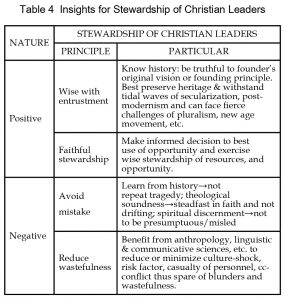
Contemporary Christian churches have the tendency of being obsessed with efficiency and dismissing research to be unnecessary and a waste of time/energy. At the leadership, sometimes may even make uninformed decision, i.e. without knowing the hard facts to be gathered by research. Missiological research is an essential part of healthy stewardship and godly leadership. For example, the LCWE movement (Lausanne Congress of World Evangelization) has formed committees to conduct research on holistic mission, BAM (business as mission), diaspora missiology, etc. In addition, there are other missiological research groups, e.g. the “Center of the Study of Global Christianity” at Gordon-Conwell Theological Seminary, Joshua Project[18] of Frontier Ventures, and Global Research of IMB[19] (International Mission Board) of Southern Baptist Convention.
CONCLUSION
In this paper, we began with definition of key terms, then use diagrams to explain the importance and significance of missiological research, proceed to explain the “what,” “why” and “how” of inter-disciplinary and integrative missiological research. Examples are given to illustrate the points practically.
APPENDIX 3
Five Tables on Interdisciplinary Study of “Diaspora Missiology”
Table 5 Integration Theories Across Disciplines
(Wan 2014:153)[20]
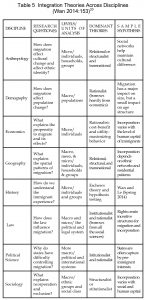
Table 6 Interdisciplinary Research Methodology –
“Missions to the Diaspora” [21][22][23][24][25][26][27][28][29]
(Wan 2014:154)
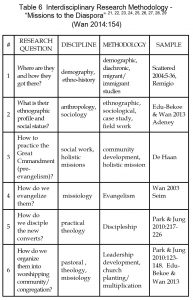
Table 7 Interdisciplinary research methodology: for
“Missions through the Diaspora”[30][31]
(Wan 2014:155)
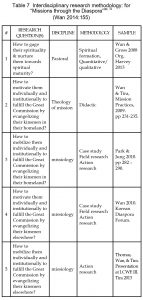
Table 8 Interdisciplinary Research Methodology: For “Missions By and Beyond the Diaspora”[32][33][34]
(Wan 2014:156)
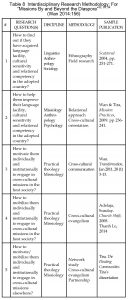
Table 9 Interdisciplinary Research Methodology: For “Missions With the Diaspora”[35][36][37][38][39][40][41][42][43]
(Wan 2014:157)
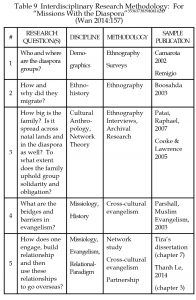
Table 10 Approaches in Ministry:
Programmatic, Managerial and Relational
(Wan 2017”133)
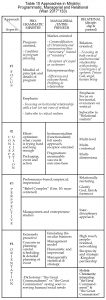
Table 11 Programmatic/Managerial/Entrepreneur and Relational Approaches in Discipleship (Individual) and Pastoral (Institutional) Levels
(Wan 2017, 135):
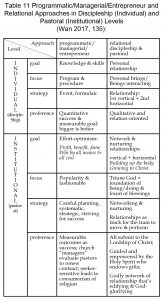
======
ENDNOTES
[1] See earlier publication — “Christian engaging in research —— following the will of God or man?” Pastoral Sharing. 2005. November: 2-6. (in Chinese)
[2] “Shalom” – The opposite of “shalom” is described in John 12:31; 1 John 3:8; 5:19 and Jesus had overcome the world and the evil one who is its ruler (1 John 2:13-14; 5:4). Shalom is a Hebrew word with connotations of peace, wholeness, and wellness in the context of right relationships with God, people, and nature (Jer 33:8-9; Job 5:24; Ps 30:11; Isa 11:6, 9; 53:5). Enoch Wan, “’Mission’ and Missio Dei: Response to Charles Van Engen’s ‘Mission defined and described’” IN Missionshift: Global Mission Issues in the Third Millennium, Edited by David J. Hesselgrave and Ed Stetzer. 2010:41-50.
[3] Enoch Wan, “The Paradigm & Pressing Issues of Inter-Disciplinary Research Methodology,” Published in Global Missiology, Research Methodology, January 2005, www.globalmissiology.net. 2005:2.
[4] Enoch Wan, “The Paradigm & Pressing Issues of Inter-Disciplinary Research Methodology,” Published in Global Missiology, Research Methodology, January 2005, www.globalmissiology.net. 2005:2
[5] The seven points of this section is taken from (pages 3-4) the article listed in footnote #6.
[6] The seven points of this section is taken from (pages 5-6) the article listed in footnote #6.
[7] Enoch Wan, Diaspora Missiology: Theory, Methodology, and Practice. IDS-USA, 2012; Yaw Attah Edu-Bekoe, Enoch Wan, Scattered Africans Keep Coming: A Case Study of Diaspora Missiology on Ghanaian Diaspora and Congregations in the USA. IDS-USA, 2013.
[8] Enoch Wan, “The Paradigm of ‘Relational Realism.’” EMS Occasional Bulletin 19:2 (Spring 2006):1-4.
______. “Relational Theology and Relational Missiology.” Occasional Bulletin 21:1 (Winter 2007): 1-7.
_______. “A Missio-Relational Reading of Romans: A Complementary Study to Current Approaches.” EMS Occasional Bulletin, Vol. 23 No. 1 (Winter 2010e):1-8. Also in Global Missiology (April 1, 2010e). Available at www.GlobalMissiology.org/
_______ & Narry Santos, “Missio-relational Reading of Mark,” Evangelical Missiological Society Occasional Bulletin, Volume 24, #2 – Spring, 2011
___________ “Relational Tree,” Published in “Relational Study”
www.GlobalMissiology.org Jan. 2011.
[9] “Church growth theory” of Donald McGavran, including “HUP” – Homogeneous Unit Principle)
[10] Religious syncretism is a taboo for evangelical practitioner due to unreserved accommodation!
[11] 即圖二第五項,便是本末倒置。有關功能論的評估,參下列兩篇專文: Enoch Wan, “Critique of Functional Missionary Anthropology” His Dominion, Canadian Theological Seminary, Canada. 1982.
[12] 即圖二第四項
[13] Enoch Wan, “Core Values of Mission Organization in the Cultural Context of the 21st Century,” Published in www.GlobalMissiology.org “Featured Article” January 2009.
[14] Enoch Wan, “Core Values of Mission Organization in the Cultural Context of the 21st Century,” Published in www.GlobalMissiology.org “Featured Article” January 2009:6-7.
[15] This section is derived from an early work: Enoch Wan, “The Paradigm & Pressing Issues of Inter-Disciplinary Research Methodology,” Published in Global Missiology, Research Methodology, January 2005, www.globalmissiology.net, p. 4-6.
[16] This section is derived from an early work: Enoch Wan & Mabiala Kenzo, “Evangelical theology, post-modernity, and the promise of inter-disciplinarity,” Global Missiology, January 2006, www.globalmissiology.org
[17] Enoch Wan, “The Paradigm & Pressing Issues of Inter-Disciplinary Research Methodology,” Published in Global Missiology, Research Methodology, January 2005, www.globalmissiology.net. P.13-14.
[18] See info @ http://joshuaproject.net/get_involved/with_joshua_project.
[19] See info @ http://public.imb.org/globalresearch/Pages/References.aspx
[20] Enoch Wan and Thanh Trung Le. Mobilizing Vietnamese Diaspora for the Kingdom. (forth coming, Spring 2014)
[21] Amador A. Remigio, Jr., “A Demographic Survey of the Filipino Diaspora,” in Scattered: The Filipino Global Presence, eds. Luis Pantoja, Jr., Sadiri Joy Tira, and Enoch Wan (Manila: Life Change Publishing, 2004), 5-36.
[22] Amador A. Remigio, Jr., “Global Migration and Diasporas: A Geographical Perspective.” in The Human Tidal Wave, by Sadiri Joy Tira. Manila: Lifechange Publishing, Inc., 2013.
[23]Yaw Attah Edu-Bekoe and Enoch Wan. Scattered Africans Keep Coming. 2013 (www.amazon.com)
[24]Miriam Adeney, “Colorful Initiatives: North American Diasporas in Mission.” in The Human Tidal Wave, by Sadiri Joy Tira. Manila: Lifechange Publishing, Inc., 2013
[25]Charlene de Haan, A Canadian Case Study in Diaspora Missiology, accessed September 23, 2009; available at http://www.lausanneworldpulse.com/perspectives.php.
[26]Enoch Wan, The Chinese Diaspora – A Case Study of Migration & Mission,” Missiology. 31, no. 1: 35. Pasadena, CA, 2003a. Accessed January 31, 2011; available at http://www.missiology.org/new/wp-content/uploads/2011/01/ChineseDiaspora-Missiology.pdf
[27] Brian Seim, “Diaspora and the Megacities: A Narrative Mode.” in The Human Tidal Wave, by Sadiri Joy Tira. Manila: Lifechange Publishing, Inc., 2013
[28] Yeong Ae Kim, “Ammi Mission Fellowship” in 21C New Nomad Era and Migrant Mission ed. Chan-Sik Park and Noah Jung (Seoul, Korea: Christianity and Industrial Society Research Institute, 2010), 217-224.
[29] Young-Sang Ro, “The Ecclesiastical Approach for the Integration of Multicultural Society: Intercultural ‘Unity in Diversity’ in the Multiethnic Ministry, ” in 21C New Nomad Era and Migrant Mission. Seoul: Christianity and Industrial Society Research Institute, by Park, Chan-Sit and Noah Jung, eds.2010, 123-148.
[30] Enoch Wan & Linda Gross, “Christian Missions to Diaspora Groups: A Diachronic General Overview and Synchronic Study of Contemporary U.S.” Global Missiology vol. 3, no. 2 (2008). Available at www.GlobalMissiology.org
[31] Thomas Alan Harvey, “Pluralism, Multiculturalism, and the Diaspora Mission: Discovering the Relevance of Apostolic Mission Today.” in The Human Tidal Wave, by Sadiri Joy Tira. Manila: Lifechange Publishing, Inc., 2013.
[32] Thanh Trung Le, “A Missiological Study of Vietnamese Diaspora,” Unpublished dissertation, Western Seminary, 2013, chapter 3.
[33] Sidiri Joy Tira, “The Floating Communities,” http://conversation lausanne.org/en/ conversations/detail/10178 (accessed 2.13.11)
[34] Sidiri Joy Tira, “Diaspora Missiology: An Ethnographic Study of Filipino Kingdom Workers, An Enthographic Study,” Unpublished dissertation, Western Seminary, 2008.
[35] Adapted from dissertation in progress: Jacques Hebért, A New Strategy for Sending Exogenous Missionaries to the Arab Muslim Context: A Diaspora Model, Western Seminary. For detailed discussion on the “with” strategy in Chapter 8 as presented by Jacques Hebért
[36] Steven A. Camarota, Immigrants from the Middle East: A Profile of the Foreign-born Population from Pakistan to Morocco. Washington D. C.: Center for Immigration Studies, 2002.
[37] Amador A. Remigio, Jr., “A Demographic Survey of the Filipino Diaspora,” in Scattered: The Filipino Global Presence, eds. Luis Pantoja, Jr., Sadiri Joy Tira, and Enoch Wan (Manila: Life Change Publishing, 2004), 5-36.
[38] Elizabeth Boosahda, Arab-American Faces and Voices: The Origins of an Immigrant Community. Austin: The University of Texas Press, 2003.
[39] Raphael Patai, The Arab Mind. Rev. ed. Tucson: Recovery Resources Press, 2007.
[40] Miriam Cooke, and Bruce B Lawrence, Muslim Networks: from Hajj to Hip Hop. Chapel Hill: The University of North Carolina Press, 2005.
[41] Phil Parshall, Muslim Evangelism: Contemporary Approaches to Contextualization. Rev. Ed. Colorado Spring: Biblica, 2003.
[42] Sidiri Joy Tira, “Diaspora Missiology: An Ethnographic Study of Filipino Kingdom Workers, An Enthographic Study,” Unpublished dissertation, Western Seminary, 2008.
[43] Thanh Trung Le, “A Missiological Study of Vietnamese diaspora,” Unpublished dissertation, Western Seminary, 2013, chapter 3.
* This paper was originally published in Chinese. Engaging in Global Mission(往普天下去). A quarterly publication of Hong Kong Association of Christian Mission. January to March, 2014.
* Published with permission.
===============
Dr. Enoch Wan is the Director of Doctor of Intercultural Studies Program, Western Seminary, USA. Former President, Evangelical Missiological Society of US & Canada.
1 Comment
Leave a Reply
You must be logged in to post a comment.

Thank you for such a great message, kindly can I get more resources to help me coordinate missiological work in East Africa.